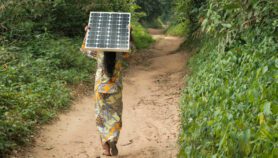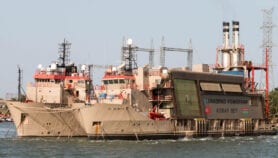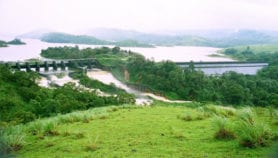Send to a friend
The details you provide on this page will not be used to send unsolicited email, and will not be sold to a 3rd party. See privacy policy.
[ABU DHABI] Once, the word of the moment was “sustainability”, and within years sustainable development became a widely-used to concept. Now, the popular term is “resilience”, and the resilience of cities to environmental and social pressures is seen as a major issue for governments and peoples around the world.
This concept underlay many of the events at the Eye on Earth Summit in Abu Dhabi (12-15 December), culminating in a panel discussion, “Innovative Cities: Designing for Resiliency and Change”, in which the role of technology, green building and access to information were highlighted.
On this showing, discusión of sustainable and resilient cities will be an important part of the International Rio+20 conference in Brazil in June 2012.
Resilience is crucial “because it is a flip side of disaster” and “a key component on the path to sustainable development that will become one of the driving forces for the next 30 years as we try to build our own future,” said the panel moderator, Jan Hartke, from the Clinton Foundation in the US.
“We want to carry this message to Rio+20,” he emphasised.
“Cities will be very visible in Rio+20,” forecast Susanne Salz, head of the secretary general’s office at Local Governments for Sustainability (ICLEI), an international association of local governments and their associations that have made a commitment to sustainable development.
“In the past we focused on climate change but now it’s resilience because cities are affected by disasters and local governments have to respond. When a city is hit by disasters it needs to bounce back, and people and governments have to learn how to do it,” said Salz.
Aspasia Camargo, a Brazilian Green Party MP, a member of the Rio+20 National Committee and a former deputy environment minister, told SciDev.Net, “Cities will be a very important chapter in Rio+20 because they are generally treated as if they were not important.”
Camargo emphasised the importance of “institutions that communicate with each other and share information” at both local and global levels.
Sophisticated system
“At Rio+20 we have to commit to empower cities because they are now in a very weak position and we have to assure them that they will be heard,” she added.
She said she expected Rio+20 to make a commitment “to planning and geographical information and hi-tech.
“It is impossible to build green cities with millions of people without a very sophisticated system of information that can use all layers of data in order to produce participatory movements. If the population aren’t involved, you cannot go ahead,” she said.
Camargo said cities were an important issue not only because they were the main source of air pollution or because they were home to half the world’s population.
“Cities also have been built up against Nature, and occupation and infrastructure were conceived as if Nature didn’t exist. Cities need to become friendly with Nature, and this requires a re-think of the relationship between Nature and human occupation to avoid the disasters and accidents that now dominate our cities,” she said.
“I would like to bring environmental resilience to cities, but also social resilience, because social resilience is indispensable if people are to adapt and protect themselves, and create planning and strategic maps to know what is going on in the different parts of a city,” she explained.
Urban areas now consume over two-thirds of the world’s energy and produce 70 per cent of global carbon emissions. On current forecasts they will accommodate 75 per cent of the global population by 2050.
Green buildings
But cities are also vulnerable to natural and man-made disasters which last year affected more than 15 million urban dwellers.
“Green buildings give us an opportunity to fix this, but only if buildings perform,” said Richard Fedrizzi, president of the World Green Building Council and a member of the Abu Dhabi conference panel.
The Green Building Council has formulated a rating system to evaluate the design, construction and operation of high performance green buildings, homes and neighbourhoods .
“In the past we didn’t know what was going on with our buildings, but now information from the system helps us make better decisions,” said Fedrizzi.
Former US president Bill Clinton, who addressed Eye on Earth participants, also referred to green buildings: “Seventy-five per cent of [carbon] emissions come from buildings,” he said, so increasing their efficiency was the most economical way to begin tackling climate change.
Naeema Al Zarouni, geographic information systems (GIS) manager at Abu Dhabi Urban Planning Council (UPC), told the panel audience about the green building rating system, Estidama, launched in 2010, which sets out mandatory sustainable practices for all new construction in the emirate.
“It started one year ago and we have reduced water consumption by 31 per cent”, said Al Zarouni.
Angela Fandino, managing director of Engineering Sustainable Futures, an Abu Dhabi company, who attended the conference, told SciDev.Net, “In Dubai, collecting data about energy, water consumption and waste generation — some of the basic variables for analysing CO2 emissions — is difficult because people are afraid of being punished or measured against benchmarks.
“But in Abu Dhabi this is a little bit different, although still there is a lot of missing data for benchmarking. It is different because of Estidama, which is doing a very good job in terms of collecting information.”
Avoid tragedies
All four members of the panel agreed that access to information and technology have an important role to play in creating sustainable cities.
“Resilience implies the capacity of a city to respond to a challenging situation, so we need environment and infrastructural information in order to avoid tragedies, or to act when it is necessary,” said Camargo.
“Neighbourhood networks are indispensable for collecting data and helping people to act or make decisions,” she added.
On technology, Al Zarouni said that geospacial information (GIS) could help decision-makers compare urban scenarios or visualise future contexts.
And Fedrizzi said that apps “will be useful to access [environmental and infrastructural] information about cities”.
“But although we are talking about data, technology and resiliency,” said Fedrizzi, “the most important [player] is the human being who will bring [these things] together in an agenda for action.
“A person can make a difference, and the information they have will empower them to work towards a better result.”













